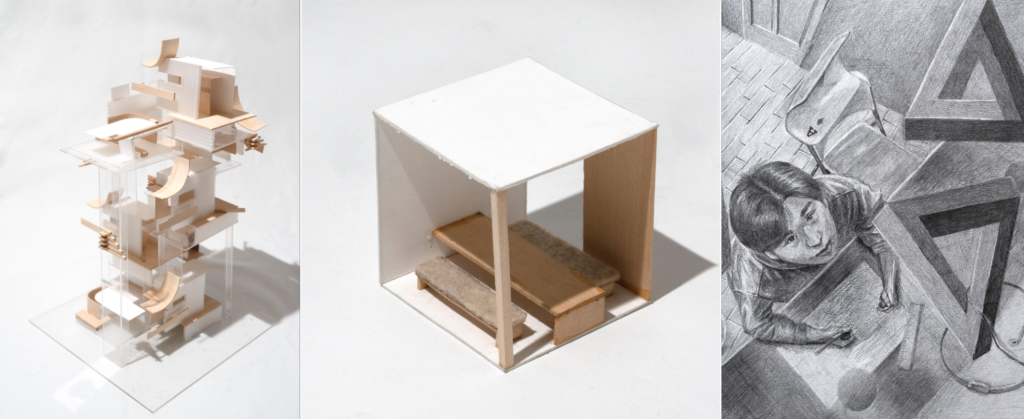The Truth About Architecture School Portfolios: What Matters and What Doesn’t.
How to Create a Strong Undergraduate Architecture Portfolio

Accepted and Merit Scholarship Student Work
Introduction
Creating a successful architecture portfolio is a critical aspect of getting admitted into an undergraduate architecture program. Many applicants misunderstand what architecture schools seek in student portfolios. Often, they focus too much on technical design and include software such as CAD and rendering software prematurely. Additionally, there is a misconception that architecture school relies heavily on mathematics, which is typically more applicable to engineering programs. Instead, your architecture portfolio needs to showcase your ability to think conceptually and solve design challenges. In this post, we’ll provide you with some tips on how to create a strong architecture portfolio as well as the reasons for them that you’ll discover once you’re enrolled. We also provide helpful links at the end of this post to some of the top school’s undergraduate portfolio requirements, including Cornell University, Pratt, and RISD.
1. Show Your Problem-Solving Skills
When creating your portfolio, it’s essential to demonstrate your problem-solving skills. Schools want to see how you approach design challenges and how you experiment with different solutions. Therefore, it’s not necessary (or even recommended) to include only building designs in your portfolio. You can also include 3-dimensional projects, graphic works, and hand drawings that showcase your creative problem-solving skills.
2. Highlight Your Ability to Reason
While art portfolios mainly exhibit a student’s creativity, architecture and design portfolios need to exhibit another critical trait: the student’s ability to reason. It’s important to showcase your thought process and how you arrived at your design solutions. This can help demonstrate your understanding of design principles and your ability to apply them in real-life scenarios.
3. Example Design Prompt
To give you an idea of how you can apply the principles we discussed in this post, here’s an example design prompt:
Choose a piece of art that inspires you, and create a 3D paper cube that reinterprets and references that artwork. Your cube should be an abstract representation of the original artwork, and should explore how you interpret and understand the themes and ideas presented in that artwork. Consider how you can use the shape and structure of a cube to create a unique representation of the original artwork. Use your cube to communicate your ideas and perspective on the artwork you have chosen. Make sure to include sketches or drawings that showcase your design process and creative problem-solving skills.

Example student work.
4. Seek Professional Input
Creating an architecture portfolio can be a daunting task, but seeking professional input can make the process less intimidating. We help you survey your existing artistic works to come up with a plan of action to start and complete your architecture portfolio. Our team of experienced instructors can help you work in graphite, paper, and wood to communicate interesting design ideas and get a head start on how a real university-level design studio can work.
5. The Importance of the Studio Setting
The studio setting is crucial for architecture students to receive constructive criticism, make and experiment. It provides a space for students to discuss and receive feedback on their ideas and engage in the hands-on making with different materials and techniques. The studio is essential for fostering a culture of innovation and growth, allowing students to develop their skills and refine their ideas through collaboration and experimentation. To that end, we recommend in-person or private-online classes to give students an authentic studio experience similar to what they will encounter in school.

6. Documentation
Documenting your work is an essential part of creating a great architecture portfolio. Not only does it allow you to showcase your thought process and design development, but it also demonstrates your attention to detail and organization skills. At New York Art Studio, we teach you the importance of proper documentation and help you learn how to present your work in a clear and concise manner. By developing these skills early on, you’ll be better prepared for success in your future academic and professional endeavors.
Extra considerations- B.Arch or B.A.? Which is right for you?
A “B.Arch” degree is a five-year professional degree that prepares graduates for the practice of architecture and is required for professional licensure. A “B.A. in Architecture” degree is an academic degree that focuses on the study of architecture but does not necessarily lead to professional licensure and can be earned in four years.
Depending on their career goals, students may choose either degree. A “B.Arch” degree is best for those who want to become licensed architects and work in the field, while a “B.A. in Architecture” degree is ideal for those who want to focus on the academic study of architecture and pursue related careers such as research, teaching, or urban planning.
PORTFOLIO REQUIREMENTS BY SCHOOL:
Below are some of the top schools for undergraduate architecture and what they say is required in an architecture portfolio. Follow the links for more information:
CORNELL ARCHITECTURE PORTFOLIO REQUIREMENTS
PRATT ARCHITECTURE PORTFOLIO REQUIREMENTS
RISD ARCHITECTURE PORTFOLIO REQUIREMENTS
Conclusion
In conclusion, creating a strong architecture portfolio requires demonstrating your problem-solving skills, highlighting your ability to reason, and seeking professional input if needed. Follow these tips to create a successful architecture portfolio that will help you stand out from the crowd and gain admission to your dream architecture program.
We’re here to help!
If you’re a high school student interested in applying to architecture school, don’t overlook the importance of a well-documented portfolio. At NY Art Studio, we offer resources to help you learn how to create stunning works to bolster your portfolio and help you reach your college goals.
Click for more information on our art portfolio prep course Undergraduate Level Prep Graduate Level Prep
Request a Consultation to learn more about our offerings
Contact New York Art Studio at info@nyartstudio.com or (212) 279 1622 to speak with one of our experts.
Let us help you showcase your artistic skills and stand out in the competitive admissions process!
Check out our Instagram @nyartstudio




